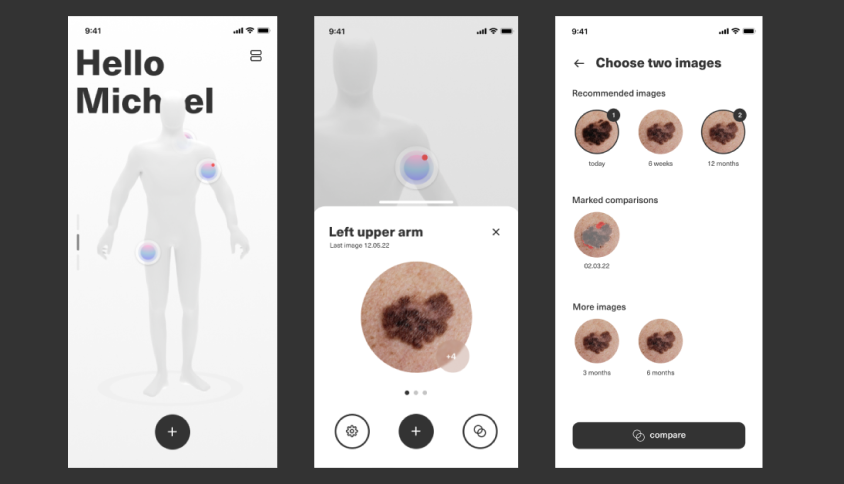02 melafy.io
MEDICAL DESIGN
Problem definition
Black skin cancer (malignant melanoma) is the most common cancer worldwide. In Germany alone, around 21,000 people contract black skin cancer every year, 3,000 die from it and the numbers are rising. In addition, skin cancer has long ceased to be a disease that only affects the elderly. ⅕ of those affected are under 50 years old.
If detected early, black skin cancer is easily treatable. Once it has been diagnosed and removed by biopsy, however, the disease is far from over. As a rule, regular, risk-adapted aftercare is carried out over a period of 10 years to ensure the early detection of recurrences or second melanomas.
For cost reasons and due to the overload of medical staff, especially in dermatology, the follow-up intervals are too far apart today. As a result, early detection can often not be guaranteed.
Design approach
At the beginning, we had a two-week Google Design Sprint and integrated the results into the subsequent design process.
In the design process, we applied various user research methods, including user journey mapping and user interviews.
By deciding to develop a modular and testable prototype early on, we were able to make adjustments quickly and iterate efficiently as the project progressed.
Our prototype combined with a functional Figma clone dummy was used as the basis for numerous interviews, testings and conversations.
We were supported in our project by real skin cancer patients, contacts from teledermatology and scientists from the DKFZ Heidelberg.
![]()
Prototyping
The prototype scanner consists of various components that were mounted in a 3D-printed case. An ESP32 DevkitC V4 was chosen as the control unit, which fulfils all the necessary functions and can be extended with further functionalities at any time. To keep the complexity of the project realistic, we did not implement the process of capturing the image and transferring it to the smartphone. Instead, we used a simulation of this process on the device and our ClickDummy to make sensible design decisions.
Design concept
Once a patient is diagnosed with black skin cancer, the doctor creates an account for them in the app and adds initial tasks. The health insurance company then sends the patient the necessary device and the patient enters a code in the app to access their account.
From this point on, the patient is no longer dependent only on the aftercare appointments, but is also enabled to additionally document conspicuous areas themselves. Over several months, the patient uses the scanner to upload images of suspicious lesions to the app, which are then reviewed by the doctor at specific intervals. If there are medical abnormalities, the doctor receives a data package consisting of a questionnaire filled out by the patient and the comparison of the images. The doctor can then evaluate this and, if necessary, arrange for the lesions to be removed.
Black skin cancer (malignant melanoma) is the most common cancer worldwide. In Germany alone, around 21,000 people contract black skin cancer every year, 3,000 die from it and the numbers are rising. In addition, skin cancer has long ceased to be a disease that only affects the elderly. ⅕ of those affected are under 50 years old.
If detected early, black skin cancer is easily treatable. Once it has been diagnosed and removed by biopsy, however, the disease is far from over. As a rule, regular, risk-adapted aftercare is carried out over a period of 10 years to ensure the early detection of recurrences or second melanomas.
For cost reasons and due to the overload of medical staff, especially in dermatology, the follow-up intervals are too far apart today. As a result, early detection can often not be guaranteed.
Design approach
At the beginning, we had a two-week Google Design Sprint and integrated the results into the subsequent design process.
In the design process, we applied various user research methods, including user journey mapping and user interviews.
By deciding to develop a modular and testable prototype early on, we were able to make adjustments quickly and iterate efficiently as the project progressed.
Our prototype combined with a functional Figma clone dummy was used as the basis for numerous interviews, testings and conversations.
We were supported in our project by real skin cancer patients, contacts from teledermatology and scientists from the DKFZ Heidelberg.

Prototyping
The prototype scanner consists of various components that were mounted in a 3D-printed case. An ESP32 DevkitC V4 was chosen as the control unit, which fulfils all the necessary functions and can be extended with further functionalities at any time. To keep the complexity of the project realistic, we did not implement the process of capturing the image and transferring it to the smartphone. Instead, we used a simulation of this process on the device and our ClickDummy to make sensible design decisions.
Design concept
Once a patient is diagnosed with black skin cancer, the doctor creates an account for them in the app and adds initial tasks. The health insurance company then sends the patient the necessary device and the patient enters a code in the app to access their account.
From this point on, the patient is no longer dependent only on the aftercare appointments, but is also enabled to additionally document conspicuous areas themselves. Over several months, the patient uses the scanner to upload images of suspicious lesions to the app, which are then reviewed by the doctor at specific intervals. If there are medical abnormalities, the doctor receives a data package consisting of a questionnaire filled out by the patient and the comparison of the images. The doctor can then evaluate this and, if necessary, arrange for the lesions to be removed.





